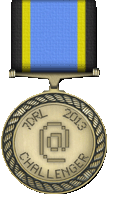: Mission Profile :
[the back story.]MyI (pronounced : my eye) is who I am, an Indie Game Developer.

MyI is also a pseudo-acronym for "MyInterface", my XBox gamer handle, taken from a Windows wordplay where everything was My-Documents, My-Downloads, My-Music, My-etc., it made sense at the time, so anyway ...
Through it all, I've found a path to APP HUB, where I can use my previous knowledge of programming languages, and there, am able to incorporate my love of art, music, logic and design.
Through tenuousity and tenaciousness I am now creating games that run on the XBox360!
How it happened.
Programming is something I have been doing since about 1979/80, or from about 16 or 17 years old. I took a class in high school that introduced me to BASIC, Beginners All Purpose Instruction Code, where they were using the Apple II with a color monitor. I started at home on a Tandy TSR-80 with an expansion interface that upgraded it to 64 kb from 32. To initialize it, a program called "keyboard de-bounce", a keyboard echo verification utility, was cassette tape loaded into RAM prior to any coding. It had a monitor, light gray on a dark gray background, and two standard cassette decks for hard drive storage. Super Star Trek was the major game. It was all text driven and the graphics, (my Enterprise <+>, enemy ships {-}, starbases [!], stars *, etc.), were built out of what are now seen as texted emoticons. I moved up to a Franklin, an Apple II (c or e I really don't know) compatible computer with a monochrome green screen. A special adapter, (probably from an old Atari game), let me view programs I built in Hi-Res (4 color) and Low-Res (16 color) resolution. The graphics could then be seen on a separate small color TV. I then had two random access 5 1/4 inch floppy drives for non-volitile storage, which was far preferable to sequential tape storage. But the game field remained the same. I still timed-out with my capacity to add more and more code. With only 64K of RAM, I fought the dreaded OUT OF MEMORY ERROR. But this is getting ahead of myself.
Following standard procedure\protocol, the Franklins 5 1/4 inch floppy was initialized by formatting it with BRUN FUD, (Binary Run File Utility Disk). CATALOG was the KeyWord that was used to access the files on the disk. This was the Disk Operating System. DOS wasn't an auto exec batch file yet as far as my computing endeavors were concerned, and that was IBM anyway. After that, NEW, told it to clear the memory of any prior programs and to reset whatever else that it needed to do. If there were blocks of coded line numbers in the unrefreshed memory, the buffer would unwittingly, (or possibly wittingly), allow an old program, or portion thereof, to be appended to the new program if they weren't deleted. This wasn't a bad way to Cut, Copy and Paste but it was backwards in a sense. TEXT (set the monitor graphics to a text page), where there were about ten assorted text, graphics and split text and graphics pages, but in using these there was a chance that the text or graphic or both pages could overwrite themselves. Finally, the programming could then start with even more cryptic commands, (cryptic at that point in time, a little less so now). But as usual, all the fun programs that were affordable were only available by typing them in in code. As a result, I found I needed to build my own error traps and self-upgrade existing text line editors to speed the programming and debugging process.
The next big step was to jump into the IBM game and buy a used 133Mhz and load in the thirteen 3.5 inch floppys of Windows 95. After that I built my own computer from scratch, or at least, pieced it together. This was just before plug-n-play when interupt requests and driver versioning had just taken over for the tiny dip switches that were buried somewhere inside the printer, mother board, etc... and out of reach, along with any discernable user manuals. There it was, a new 550Mhz with a CD, super VGA, outboard sound and the internet with dial-up. That became the home of Microsofts Visual Studio 6.0 sp5, or sp6. MS Visual Basic was the game of choice. I was soon building applications, building libraries of user controls and learning how to use GDI, the Graphics Device Interface, when, of course, Visual Studio 6.0 was soon unsupported, and then non-supported, per usual.

.NET had arrived on the scene and I was back at the University. With MS Visual Studio 2003 in hand and Visual Basic in my back pocket, I left behind the grand and monolithic approach to coding and learned C++ with its modular design. My learning curve was better than most, but object oriented programming forced me to change the way I had learned to code over those many years. Then, as luck, or design would have it, the MS XNA Game Studio, which is used to build console games on the PC to port over to the XBox360, uses C# as its programming language, a managed code flavor of C++.
Through APP HUB, MSDN, the XNA Game Studio and my membership namespace "MyI", I can put everything that I have learned into focus, as FarNiche.
THE END, Part I.
THE START, Part II.
MyI@FarNiché.com




